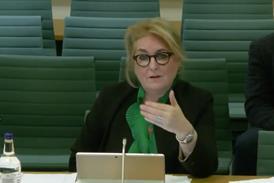For many years overriding interests in registered land have been the centre of debate (see s.70 of the Land Registration Act 1925).
One reason for such controversy is the nature of this group of interests which '...
have the character of legal estates, in that they bind even a purchaser for value without notice of them' (see Ruoff and Roper, Registered Conveyancing, fifth edition, p.102).
This group of overriding interests is described as well-recognised burdens that are easily discoverable, although they cannot be conveniently entered onto the register.
Furthermore, s.3 of the Land Registration Act 1925 states that overriding interests automatically bind the third-party purchaser, notwithstanding that they cannot be ascertained by merely looking at the register of title, or the fact that the third-party purchaser is not actually aware of their existence.Yet the fundamental principle behind registered land is the 'mirror principle', which is to 'reflect accurately and completely and beyond all argument the current facts that are material to a man's title' (TBF Ruoff, An Englishman looks at the Torrens System, p.9).
Registered land, however, puts the burden on the purchaser who has physically to inspect the land itself and make enquiries of persons living there.
The purchaser is faced with the problem of finding out as much as he or she can before purchasing the land.
This burden distorts 'absolute certainty which is the ideal of all registered systems throughout the world' (ibid,p.878) to the extent that, 'absolute title becomes something of a misnomer,' (Sir John Stewart-Wallace).There appears to be a contradiction between the idea behind registered land and the group of overriding interests in registered land.
This contradiction leads to the distortion of the mirror image which many call the 'crack' in the 'mirror principle'.
In order to assess the 'crack' and the extent of it, it is necessary to examine particular controversial sections of the group, in the light of recent cases.The first group to be examined in s.70 is s.70(1)(a).
MP Thompson critically examined the wording of s.70(1)(a), identifying inconsistencies and the extent of the 'crack'.
The words focused on are 'easements not being equitable easements required to be protected by notice on the register'.
One problem with s.70(1)(a) is whether or not equitable easements come within the category of overriding interests.
What does the section mean? The 1925 Act includes in the category of overriding interests only equitable easements not required to be protected by notice on the register.
However, nothing in the 1925 Act requires equitable easements to be protected by notice on the register.Until recently, only the county court decision in Payne v Adams (1971) CLY 6486 stated equitable easements as overriding interests.
Yet there is no uniformity of opinion among academics.
Therefore, there is a reluctance to construe equitable easements as overriding interests and a desired approach of construing s.70(1)(a) as narrowly as possible to enhance the reliability of the register (contrast William & Glyn's Bank v Boland [1981] AC 487) and minimise the extend of the 'crack' left in s.70(1)(a).
Does it seem right that equitable profits should be included as overriding interests and exclude equitable easements (see Mason v Clarke [1955] AC 718)? What was the intention in the drafting of s.70(1)(a)? Was the 'crack' intended to be as cavernous as illustrated?If one refers to the Royal Commission report of 1857 for an answer, the commission merely states the rights to be included in the category of overriding interests as those 'evidenced by known usage or continued enjoyment or [as] may be ascertained on the spot by inspection or injury'.
It seems the commission did not anticipate problems that would be encountered in the 20th century and indeed the 'crack' deepening with the development of property law.
If one turns to s.18 of the Land Transfer Act 1875, equitable easements were overriding interests and it is uncertain whether this position is to be changed or meant to change.Another argument could be that equitable easements are not within s.70(1)(a).
This argument was not accepted in Celsteel Ltd v Alton House Holding Ltd [1985] 2 All ER 572.
Here, Scott J held that, if equitable interests were construed narrowly and excluded from para (a), then there would exist a wide category of overriding interests, despite being undiscoverable by a purchaser of the servient tenement.
The wording of para (a) as a matter of construction does not exclude equitable easements which means accepting equitable easements as being overriding interests.
If that is so, then it could be insisted that such rights display the generally accepted characteristics of an easement to exclude various rights from becoming overriding interests.
To do otherwise would mean eroding the reliability of the register, particularly where the registered proprietor is not entitled to an indemnity to compensate for loss caused by overriding interests as in Re Charwood's Reg Land [1933] Ch 547.
Scott J stated that if s.70(1)(a) remained, the extent of the problem may become even more considerable.
He went on to add that, to avoid such problems, a narrow definition of equitable easements ought to be adopted.
The major contribution of this case to the assessment of the 'crack' has been to illustrate just how wide it has become.
The case decided not to treat the ambiguous wording of s.70(1)(a) as excluding all equitable easements.The Law Commission 1987 suggests that equitable easements arise where legal easements requiring registration are not registered.
When these equitable easements are registered, r.258 of the Land Registration Rules 1925 will treat them as overriding interests.
The problem starts here as it is suggested that the draftsman of r.258 took the words of s.62 of the 1925 Act and applied them to the servient land instead of to the benefit created.
The Law Commission suggests it would be more appropriate to protect these interests as minor interests and no longer protect them as overriding interests.Another group within s.70 which should be examined is s.70(1)(g).
The area of controversy is the protection given to every person 'in actual occupation' of the land sold to a third-party purchaser, making it an overriding interest.
The meaning of 'actual occupation', while including occupiers' right, covers relationships of many kinds and does not differentiate between occupation as a source and consequence of an interest (see National Provisional Bank Ltd v Ainsworth [1965] AC 1175).
The problem of construction arose in Hodgson v Marks [1971] Ch 892.
It was decided that even where the vendor is in occupation, a purchaser must pay heed to others occupying the premises.
'Actual occupation', in fact, is extended to include the mere physical presence of someone other than the vendor.
The latter was determined by Lord Denning MR, as he then was, in William & Glyn's Bank v Boland [1979] Ch 312: 'Actual occupation is a matter of fact not a matter of law.'The outcome of the Boland case is that the purchaser will find it extremely difficult to detect such interests, if at all.
The burden of investigating and identifying persons to whom to put enquiries will be put onto the purchasers and conveyancers.
Surely the Law Commission did not intend the 'crack' in the 'mirror principle' to be as cavernous, as it stated that overriding int erests were those ascertained on the spot of inspection.
However, if the person with the interest is not available on inspection, how can the interest be ascertained? The 'benefit' of the overriding interest may be vital (to the occupier), and the burden 'devastating' to the purchaser.
First, the conveyancer will experience difficulty in locating all the owners of the interest.
Secondly, collusion between equitable co-owners might unjustly prejudice purchasers, where the interest of one co-owner is deliberately concealed by the other.
Thirdly, interests that can be registered will not be -- as not registering them will make them overriding.The Court of Appeal's decision in William & Glyn's Bank v Boland leads to more problems for the purchaser or mortgagee concerning the duty of enquiry, especially where the spouse claims an overriding interest behind a trust for sale of the matrimonial home.
The extent of this duty of enquiry was criticised in the case of Kling v Keston Properties Ltd (1985) 49 P & CR 212, as the scope of s.70(1)(g) is too wide, applying to interests which should be protected on the register and, in a number of circumstances where no person other than the registered proprietor was in apparent occupation, making the interest virtually undiscoverable.
Clearly, the duty of enquiry is placed on the purchaser in order to take the land free of overriding interests.
He or she will still have to make enquiries of others who occupy the land.
The test of actual occupation will always be a factual one.The irony about the duty of enquiry is that it can amount to nothing, as was illustrated by the case of Kingsnorth Finance Co Ltd v Tizard [1986] 1 WLR 783.
In that case the vendor had arranged to have an inspection of his house by the plaintiff's agent on a particular day, when his wife was not to be in.
Judge John Finly QC stated in that case: 'How then is a purchaser or mortgagee to carry out such inspection as "ought reasonably be made" for the purposes of determining whether the possession and occupation of the property accords with the title offered?' (pp.
794-5).Furthermore, in the case of fraud or estoppel, the occupier will not be able to enforce his or her right against the purchaser (see Hodgson v Marks [1971] Ch 892 and Spiro v Lintern [1973] 1 WLR 1002).
What then is the purpose of the enquiry proviso in s.70(1)(g) if inspection will not reveal much, if anything? Fraud and estoppel need not be investigated as they are not enforceable.
In addition, there may be actual occupation through the agency of another person and if the vendor appeared in occupation, a person can still be in actual occupation.
This surely illustrates the deepening of the 'crack' in the 'mirror principle' of registered land.
In order to narrow the 'crack', the class of overriding interests may be made more certain by narrowing the class.
On the grounds of public policy, there will perhaps always be interests which will need protection against the purchaser, where it will be unreasonable to register the interests.
Therefore, the extent of the 'crack' can never really get away from third- party interests, which is just as important as having quicker and cheaper conveyancing.The 'Boland' report (Law Commission No.115) in 1982 highlighted another problem of overriding interests, which was the outcome of the decision in Re Boyle's Claim [1961] 1 WLR 339.
Re Boyle's Claim decided the date of registration of title would be the date for determining whether or not the register would be subject to overriding interest by actual occupation.
The reason for this was that, until that date, the purchaser will be deemed to be the proprietor of the legal title.
The register of title will never reflect the actual occupation which may arise between the date of disposition and the date of registration, creating what is known as 'the registration gap'.
The purchaser of registered land has the added burden of trying to ensure that no one occupies the property before registration is effected.The Law Commission 1987 recommended that, to eliminate the 'gap', the relevant date for deciding when the purchaser or lender takes subject to the overriding interest, should be moved to the date of completion, as in unregistered land.
It seems this recommendation was followed in the recent case of Lloyd's Bank plc v Rosset and Rosset [1988] 3 WLR 1301.
This case decided that the relevant date for testing occupation was the date of completion, rather than registration of title.One of the questions in Rosset was whether the wife could claim her interest as having priority over the rights of the bank under legal charge (see s.70(1)(g) of the 1925 Act).
In the Court of Appeal, Nicholls LJ acknowledged the difficulties of s.20 of the 1925 Act which focused on the position at the time of registration and s.70(1)(g), which gave rights to persons in occupation of the land at the time when the purchaser or mortgagee acquired the estate or interest.
This difficulty was due to the 'gap' between completion and registration.
Nicholls LJ went on to say that once completion had taken place the 'die had been cast'.
All the necessary searches and enquiries of occupiers would have been made by the completion and money would have been given to the purchaser.
If s.20 was applied it would mean that the purchaser would take the law subject to the interests of the newly arrived occupant, which would make the pre-completion searches and enquiries a 'conveyancing absurdity'.Instead, the majority in the Court of Appeal, deciding to look at para (g) itself, stated it was the aim of the paragraph to protect the rights and interests of those in 'actual occupation' at the time the estate or interest is created.The crucial point for Ms Rosset was whether or not she was in actual occupation at the time of completion.
The argument in Ms Rosset's favour was the fact that she supervised the work on the building, plus doing some decorating herself.
It may be argued that the builders occupied as agents or representatives of Ms Rosset, who would be therefore in actual occupation.Lord Justice Mustill dissented from the majority opinion by saying that by the development of the doctrine of notice in para (g), this was merely preparing the home and she was not really there in occupation.
Therefore, the bank had no opportunity to discover her interest.
However, Lord Wilberforce in Boland stated that the doctrine of notice plays no part in registered conveyancing.R J Smith (1988 104 LQR 511) submits that the majority decision in the Court of Appeal was correct.
He feels that the purchaser seeing Ms Rosset supervising the builders was all that could be expected of actual occupation in a derelict house.
R J Smith concludes that 'discoverability of interests is irrelevant once there is actual occupation'.
The implication of Rosset on overriding interests from para (g), is that the problems encountered in the Boland case will be narrowed (31).
Moving the relevant date of 'actual occupation' to the completion will put less burden on the purchasers' enquiry as the property is usually vacant on completion.
Another point raised i n Rosset was that purchasers' builders may constitute 'actual occupation' and not just apply to residence.
Although those points have made enquiries easier, they may still leave problems.
One such problem of enquiry may be encountered if the keys are handed to the purchaser before completion.
If one of the new occupants has an interest in the property, by moving in before completion he or she might get priority over the mortgagee if he or she knew nothing of the mortgagee.In the recent case of Abbey National Building Society v Cann (1989), the Court of Appeal agreed with the decision in Rosset that the date for establishing whether or not overriding interests exist would be the date of completion.
The Cann case also agreed that actual occupation could be claimed through the presence of agents; the idea being to protect the mortgagee who has searched the register, inspected the property, made enquiry of the mortgagor and parted with money on good faith.However, the mortgagee, usually the building society, will still be subject to the interest of an occupier (assuming at the date of completion of the purchase, the occupier was not in occupation), unless practical steps are taken.
One such step may be to insist that the person in occupation signs a document disclaiming any equitable interest or postponing it to the mortgagee.
Another may be to appoint a second trustee to the contract, so the purchase price is paid to two trustees and the mortgagee will thereby overreach the overriding interest.Nevertheless, the test of actual occupation will always be a factual one.
Until legislation makes clear specifications on what particular interests can qualify, the concerns of overriding interests will remain.

























No comments yet